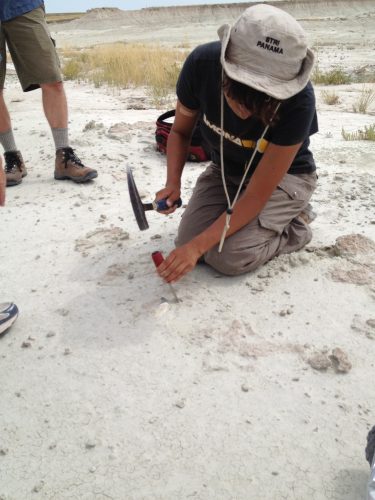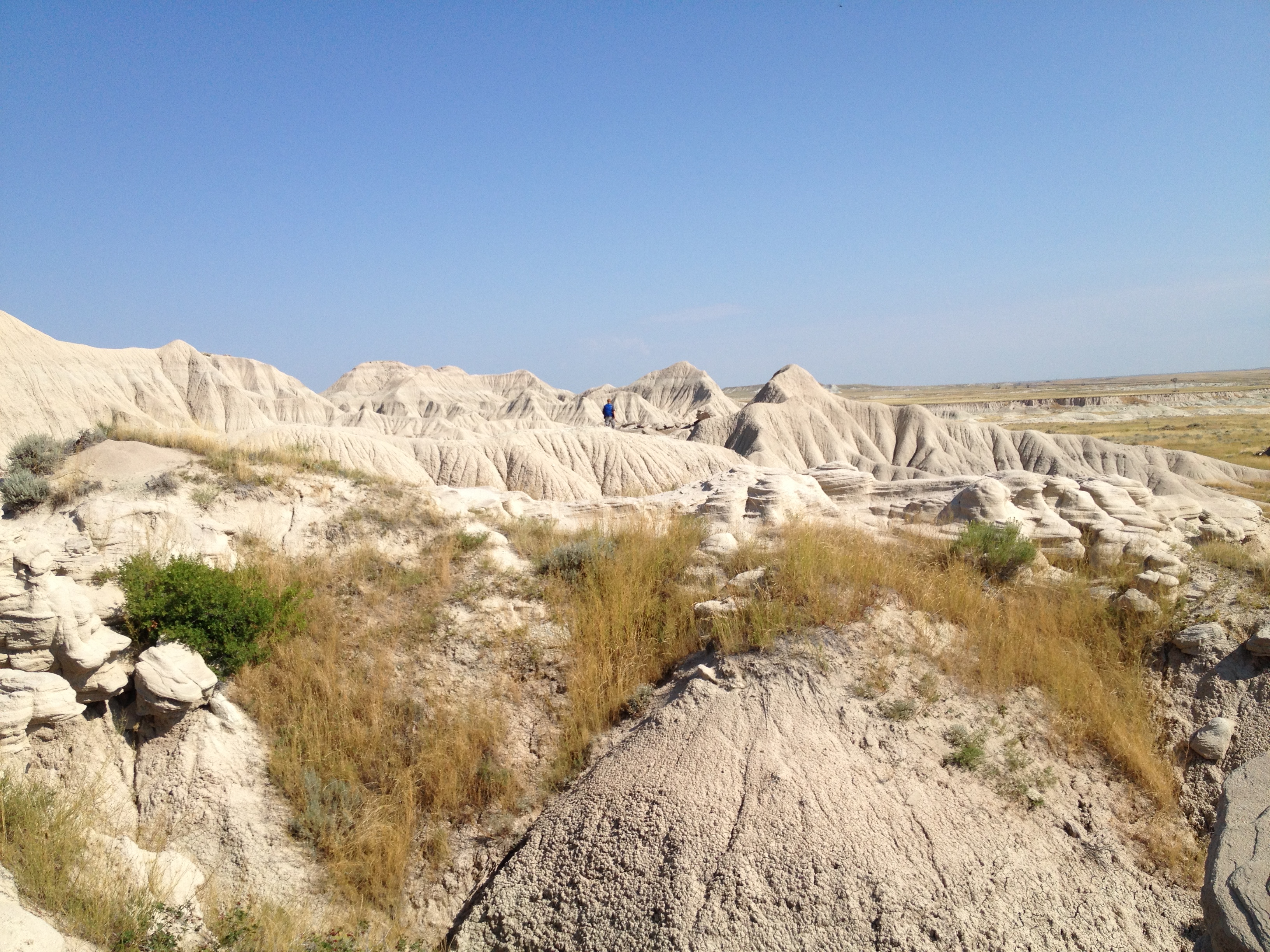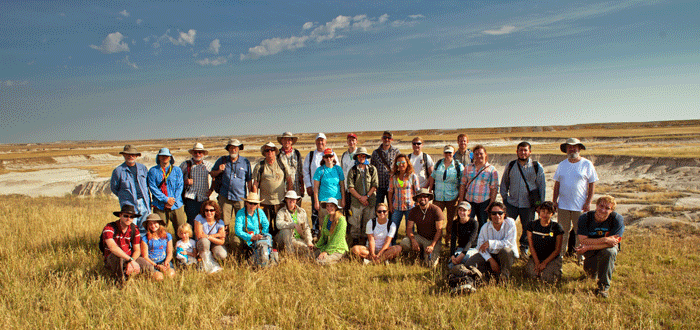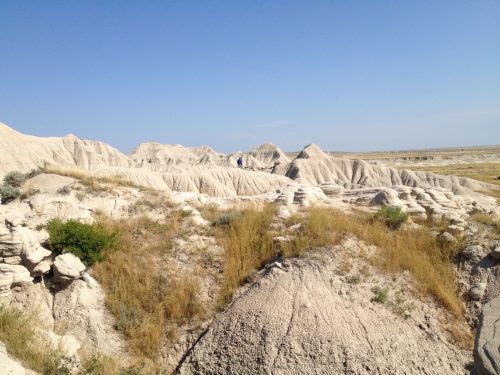By Aaron Wood and Cristina Robins | PCP PIRE Staff
Each year the PCP-PIRE group holds an “All Hands Meeting”, a gathering of the project’s many participants and stakeholders to discuss the progress made on our project goals and make plans for the future. This year’s meeting (Aug. 10-14), however, was a bit different from our typical conference-style format. Over 30 students, scientists and other PCP PIRE stakeholders ventured on a field trip to northwestern Nebraska to learn about the rocks and fossils that form the basis of our understanding of the fossil record of Panama. Our group’s home base was Fort Robinson State Park near Crawford. The bucolic location, team-based fossil collecting and family-style housing and dining were perfect for facilitating learning and discussion without any unnecessary formalities.

Northwestern Nebraska includes the “type areas” for five North American Land Mammal Ages (NALMA), subdivisions of geological time based on the fossil mammals that lived during those intervals. Many of these Nebraska localities are the same age as important fossil localities in Panama (e.g., the Centenario Bridge) and Florida (e.g., Thomas Farm), both of which many PCP PIRE participants are familiar with. The trip was a chance for many of us to see how interconnected these regions of North and Central America are in terms of their fossil records, noting the similarities and differences in the respective ancient ecosystems and environments.
Three days were spent on both fieldwork and geo-tourism. On Monday, the first day of the field conference, the group started out with a geologic tour of the stratigraphy of Toadstool Geologic Park and ended the morning with a lunchtime tour of the 12,000 year-old Hudson-Meng bison kill site within the Nebraska badlands. The afternoon of fossil prospecting and collecting in Chadronian age strata was particularly successful, with numerous teeth (both isolated and within jaws) and many other well-preserved skeletal elements collected via permission from the U. S. Forest Service. All the collected material will reside at FLMNH for future research and education.
Monday evening we had a group discussion concerning the K-12 outreach and education initiatives, as well as hearing from current and past interns about their international experience and education opportunities within the project. PCP PIRE has unquestionably been making a large impact on the interns’ education and roles as global citizens; the addition of GABI-RET (detailed here in the ‘People’ portion of the newsletter) will only solidify and expand that positive impact.

Tuesday we spent the morning exploring roadside outcrops and hiking around the Agate Fossils National Monument. No collecting was allowed, but the rich bone deposits and local history as described by the informative National Park Service rangers had us enthralled. We spent the afternoon prospecting again in the Nebraskan badlands to little success, but we were able to regroup and revitalize over an informal, delicious banquet dinner at the Drifter’s Cookshack, a rustic restaurant on the edges of the badlands.
Our final day in the field was specifically for collecting. We spent the morning at more Chadronian fossil sites, with some groups striking gold (finding wonderful teeth), and others striking out (no well-preserved fossils in the areas they explored). PCP PIRE PI Gary Morgan led an assault on anthills; apparently the ants disturb the sediment and unearth small teeth. Under his direction, multiple rabbit teeth were unearthed by sieving through the anthill detritus.
Wednesday afternoon we returned to Toadstool Geologic Park for more focused collecting, as well as collecting fossils we had discovered on our tour Monday morning, prudently leaving the park upon the signs of a building thunderstorm. In badlands areas such as the one we were exploring, thunderstorms can cause flash flooding conditions, as well as wash out the unpaved roads. Luckily we avoided that storm.
Our final “wrap up” meeting consisted of PI Carlos Jaramillo reviewing research progress on the grant thus far, as well as establishing time frames for current research projects to be published. External advisors Carmala Garzione and Thure Cerling, as well as PI Bruce MacFadden suggested exploring additional research avenues and setting tangible goals for the final official year of the project.
Despite our red-eye flights at the end of the field conference, we left (mentally) energized and with a greater sense of camaraderie that will serve us well going into our fifth year on the project, leading many of us asking ourselves “Why didn’t we do this sooner?”

Por Aaron Wood & Cristina Robins | PCP PIRE Staff
Cada año, el grupo PCP PIRE lleva a cabo un “Encuentro Todas las Manos”, una reunión de los varios participantes e interesados en el proyecto para discutir sobre el progreso en los objetivos trazados y hacer planes para el futuro. El encuentro de este año (del 10 al 14 de agosto), sin embargo, fue un poco diferente al de nuestro típico formato de conferencia. Más de 30 estudiantes, científicos y otros interesados en el PCP PIRE se aventuraron en un viaje de campo al noroeste de Nebraska para aprender sobre las rocas y fósiles que formaron las bases para nuestro entendimiento del registro fósil en Panamá. La base de nuestro grupo fue el parque estatal Fort Robinson, cerca de Crawford. La locación bucólica, colecta de fósiles en equipo y el alojamiento y cena estilo familiar fueron perfectos para facilitar el aprendizaje y discusión sin ninguna innecesaria formalidad.

El noroeste de Nebraska incluye las “localidades tipo” de cinco Edades Mamífero Norteamericanas (NALMA por sus siglas en inglés), subdivisiones del tiempo geológico basadas en los mamíferos fósiles que vivieron durante aquellos intervalos. Varias de estas localidades en Nebraska tienen la misma edad que importantes localidades fósiles en Panamá (e.g., el Puente Centenario) y Florida (e.g., Thomas Farm), con las cuales varios participantes del PCP PIRE están familiarizados. Este viaje fue una oportunidad para que varios de nosotros viéramos cómo estas regiones de Norteamérica y Centroamérica estaban interconectadas en términos de sus registros fósiles, notando las similaridades y diferencias respecto a los ecosistemas y ambientes antiguos.
Tres días fueron empleados en trabajo de campo y geoturismo. El lunes, el primer día de la conferencia de campo, el grupo comenzó con un tour geológico a la estratigrafía del parque geológico Toadstool y terminó con una visita al lugar de matanza de bisones Hudson-Meng de 12000 años de antigüedad, en los badlands de Nebraska. La tarde de prospección y colecta de fósiles en el estrato de edad Chadroniana fue particularmente exitosa, con numerosos dientes (tanto aislados como otros dentro de mandíbulas) y varios otros elementos óseos bien preservados colectados con permiso del Servicio Forestal de los Estados Unidos. Todo el material colectado permanecerá en el Museo de Historia Natural de Florida para futuras investigaciones y actividades educativas.
La noche del lunes tuvimos una discusión grupal concerniente a las iniciativas de educación y difusión del grupo K-12, así como una sesión en la que los practicantes actuales y pasados del proyecto expresaron su experiencia en el extranjero y oportunidades de educación dentro del proyecto. El PCP PIRE sin lugar a dudas ha impactado enormemente en la educación y roles de los practicantes como ciudadanos globales; la adición del GABI-RET (detallado aquí en la porción educativa del newsletter) solidificará y expandirá este impacto positivo.

El martes pasamos la mañana explorando afloramientos en las carreteras y haciendo excursiones alrededor del Monumento Nacional de Fósiles Ágata. Ninguna colecta estaba autorizada, pero los depósitos ricos en huesos e historia local como es descrita por los informativos guardabosques del Servicio Nacional de Parques nos tenían cautivados. Pasamos la tarde prospectando nuevamente los badlands de Nebraska con poco éxito pero pudimos reagruparnos y revitalizar con una deliciosa e informal cena banquete en el Drifter’s Cookshack, un restaurante rustico en los bordes de los badlands.
Nuestro último día en el campo fue específicamente para colectar. Pasamos la mañana en más sitios fósiles Chadronianos, con algunos grupos encontrando oro (encontrando algunos maravillosos dientes) y otros sin encontrar nada (sin fósiles bien preservados en las áreas que exploraron). Uno de los investigadores principales del PCP PIRE, Gary Morgan, encabezó un ataque a hormigueros; aparentemente las hormigas disturban el sedimento y desentierran pequeños dientes. Bajo su dirección, múltiples dientes de conejos fueron desenterrados tamizando el detritus de los hormigueros. La tarde del miércoles retornamos al parque geológico Toadstool para una colecta más enfocada, así como para colectar los fósiles que habían sido descubiertos en nuestro tour de la mañana del lunes , prudentemente dejados en el parque por los signos de una tormenta venidera. En los badlands como los que estábamos explorando, las tormentas pueden causar condiciones de inundación repentinas, así como lavar los caminos sin pavimentar. Por suerte, evitamos aquella tormenta.
En nuestro encuentro final, Carlos Jaramillo (también investigador principal del proyecto) hizo una revisión del progreso de la investigación del proyecto hasta la fecha, así como el establecimiento de plazos para los proyectos de investigación actual que serán publicados. Los asesores externos Carmala Garzione y Thure Cerling, así como el investigador principal Bruce MacFadden, sugirieron explorar vías adicionales de investigación y el establecimiento de metas tangibles para el final del año oficial del proyecto.
A pesar del cansancio al final de la conferencia, nos fuimos (mentalmente) energizados y con un mayor sentido de camaradería que nos servirá bien para entrar a nuestro quinto año del proyecto, por lo que muchos de nosotros nos preguntamos “porqué no hicimos esto antes?”